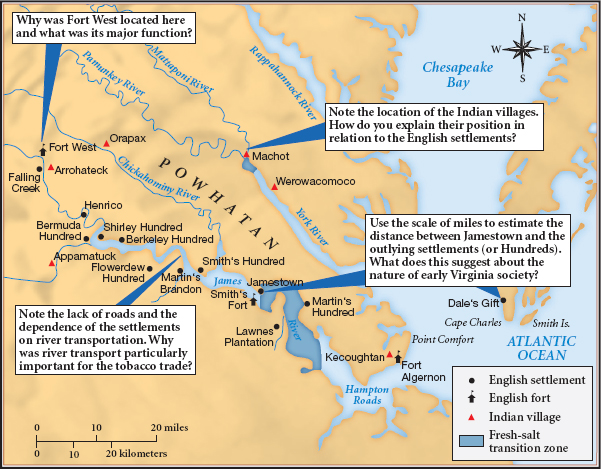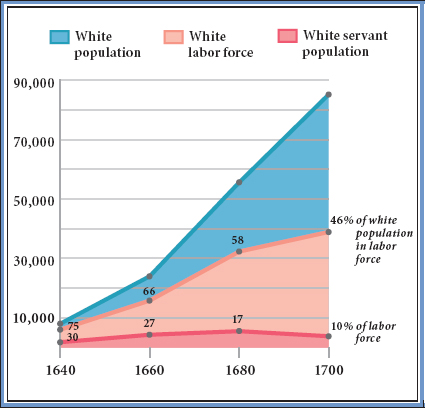America’s History: Printed Page 53
America: A Concise History: Printed Page 44
America’s History: Value Edition: Printed Page 44
Plantation Life
In North America and the Caribbean, plantations were initially small freeholds, farms of 30 to 50 acres owned and farmed by families or male partners. But the logic of plantation agriculture soon encouraged consolidation: large planters engrossed as much land as they could and experimented with new forms of labor discipline that maximized their control over production. In Virginia, the headright system guaranteed 50 acres of land to anyone who paid the passage of a new immigrant to the colony; thus, by buying additional indentured servants and slaves, the colony’s largest planters also amassed ever-greater claims to land.
European demand for tobacco set off a forty-year economic boom in the Chesapeake. “All our riches for the present do consist in tobacco,” a planter remarked in 1630. Exports rose from 3 million pounds in 1640 to 10 million pounds in 1660. After 1650, wealthy migrants from gentry or noble families established large estates along the coastal rivers. Coming primarily from southern England, where tenants and wage laborers farmed large manors, they copied that hierarchical system by buying English indentured servants and enslaved Africans to work their lands. At about the same time, the switch to sugar production in Barbados caused the price of land there to quadruple, driving small landowners out.

For rich and poor alike, life in the plantation colonies of North America and the Caribbean was harsh. The scarcity of towns deprived settlers of community (Map 2.4). Families were equally scarce because there were few women, and marriages often ended with the early death of a spouse. Pregnant women were especially vulnerable to malaria, spread by mosquitoes that flourished in tropical and subtropical climates. Many mothers died after bearing a first or second child, so orphaned children (along with unmarried young men) formed a large segment of the society. Sixty percent of the children born in Middlesex County, Virginia, before 1680 lost one or both parents before they were thirteen. Death was pervasive. Although 15,000 English migrants arrived in Virginia between 1622 and 1640, the population rose only from 2,000 to 8,000. It was even harsher in the islands, where yellow fever epidemics killed indiscriminately. On Barbados, burials outnumbered baptisms in the second half of the seventeenth century by four to one.

Indentured Servitude Still, the prospect of owning land continued to lure settlers. By 1700, more than 100,000 English migrants had come to Virginia and Maryland and over 200,000 had migrated to the islands of the West Indies, principally to Barbados; the vast majority to both destinations traveled as indentured servants (Figure 2.2). Shipping registers from the English port of Bristol reveal the backgrounds of 5,000 servants embarking for the Chesapeake. Three-quarters were young men. They came to Bristol searching for work; once there, merchants persuaded them to sign contracts to labor in America. Indentured servitude contracts bound the men — and the quarter who were women — to work for a master for four or five years, after which they would be free to marry and work for themselves.
For merchants, servants were valuable cargo: their contracts fetched high prices from Chesapeake and West Indian planters. For the plantation owners, indentured servants were a bargain if they survived the voyage and their first year in a harsh new disease environment, a process called “seasoning.” During the Chesapeake’s tobacco boom, a male servant could produce five times his purchase price in a single year. To maximize their gains, many masters ruthlessly exploited servants, forcing them to work long hours, beating them without cause, and withholding permission to marry. If servants ran away or became pregnant, masters went to court to increase the term of their service. Female servants were especially vulnerable to abuse. A Virginia law of 1692 stated that “dissolute masters have gotten their maids with child; and yet claim the benefit of their service.” Planters got rid of uncooperative servants by selling their contracts. In Virginia, an Englishman remarked in disgust that “servants were sold up and down like horses.”
Few indentured servants escaped poverty. In the Chesapeake, half the men died before completing the term of their contract, and another quarter remained landless. Only one-quarter achieved their quest for property and respectability. Female servants generally fared better. Because men had grown “very sensible of the Misfortune of Wanting Wives,” many propertied planters married female servants. Thus a few — very fortunate — men and women escaped a life of landless poverty.
African Laborers The rigors of indentured servitude paled before the brutality that accompanied the large-scale shift to African slave labor. In Barbados and the other English islands, sugar production devoured laborers, and the supply of indentured servants quickly became inadequate to planters’ needs. By 1690, blacks outnumbered whites on Barbados nearly three to one, and white slave owners were developing a code of force and terror to keep sugar flowing and maintain control of the black majority that surrounded them. The first comprehensive slave legislation for the island, adopted in 1661, was called an “Act for the better ordering and governing of Negroes.”
In the Chesapeake, the shift to slave labor was more gradual. In 1619, John Rolfe noted that “a Dutch man of warre … sold us twenty Negars” — slaves originally shipped by the Portuguese from the port of Luanda in Angola. For a generation, the number of Africans remained small. About 400 Africans lived in the Chesapeake colonies in 1649, just 2 percent of the population. By 1670, that figure had reached 5 percent. Most Africans served their English masters for life. However, since English common law did not acknowledge chattel slavery, it was possible for some Africans to escape bondage. Some were freed as a result of Christian baptism; some purchased their freedom from their owners; some — like Elizabeth Key, whose story was related at the beginning of the chapter — won their freedom in the courts. Once free, some ambitious Africans became landowners and purchased slaves or the labor contracts of English servants for themselves.
Social mobility for Africans ended in the 1660s with the collapse of the tobacco boom and the increasing political power of the gentry. Tobacco had once sold for 30 pence a pound; now it fetched less than one-tenth of that. The “low price of Tobacco requires it should bee made as cheap as possible,” declared Virginia planter-politician Nicholas Spencer, and “blacks can make it cheaper than whites.” As they imported more African workers, the English-born political elite grew more race-conscious. Increasingly, Spencer and other leading legislators distinguished English from African residents by color (white-black) rather than by religion (Christian-pagan). By 1671, the Virginia House of Burgesses had forbidden Africans to own guns or join the militia. It also barred them — “tho baptized and enjoying their own Freedom” — from owning English servants. Being black was increasingly a mark of inferior legal status, and slavery was fast becoming a permanent and hereditary condition. As an English clergyman observed, “These two words, Negro and Slave had by custom grown Homogeneous and convertible.”
COMPARE AND CONTRAST
Question
How were the experiences of indentured servants and slaves in the Chesapeake and the Caribbean similar? In what ways were they different?